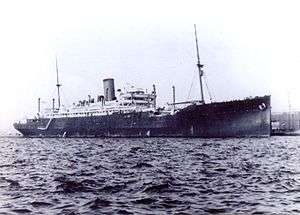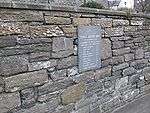HMS Jervis Bay
 Jervis Bay at Dakar in 1940 | |
| History | |
|---|---|
| Name: | HMS Jervis Bay |
| Builder: | Vickers Limited, Barrow-in-Furness |
| Launched: | 1922, as SS Jervis Bay |
| Acquired: | August 1939 |
| Commissioned: | October 1940 |
| Fate: | Sunk, 5 November 1940 |
| General characteristics | |
| Type: | Armed Merchant Cruiser |
| Displacement: | 14,164 long tons (14,391 t) |
| Length: | 549 ft (167 m) |
| Beam: | 68 ft (21 m) |
| Draught: | 33 ft (10 m) |
| Speed: | 15 knots (28 km/h; 17 mph) |
| Complement: | 254 |
| Armament: | |
HMS Jervis Bay was a British liner later converted into an armed merchant cruiser, pennant F40. She was launched in 1922, and sunk on 5 November 1940 by the German pocket battleship Admiral Scheer.
Design
The ship was launched as the Aberdeen & Commonwealth Line steamer Jervis Bay, named after the Australian bay of that name (the line named all its ships after bays). She was requisitioned by the Royal Navy in August 1939 at the outbreak of the Second World War, and armed with seven 1898-vintage 6 in (150 mm) guns and two 3 in (76 mm) guns of 1894 design.
Service history
After her acquisition and commissioning, Jervis Bay was initially assigned to the South Atlantic station before becoming a convoy escort in May 1940. She was the sole escort for 37 merchant ships in Convoy HX-84 from Halifax, Nova Scotia to Britain, when the convoy encountered Admiral Scheer. The Captain of Jervis Bay, Edward Fegen, ordered the convoy to scatter; and set a course towards the German warship to draw its fire, with guns firing more as a distraction than in the hope of doing damage.[1] Jervis Bay was hopelessly outgunned and outranged by the 28 cm (11 inch) guns of the German ship. Fegen and his crew fought on until their ship was set ablaze and sunk 755 nautical miles (1,398 km) south-southwest of Reykjavík. Captain Fegen went down with his ship.[2] Nevertheless, although Admiral Scheer went on to sink five merchant ships out of the convoy, Jervis Bay's sacrifice bought enough time for the convoy to scatter and the remaining ships escaped. Sixty-eight survivors of Jervis Bay's crew of 254 were picked up by the neutral Swedish ship Stureholm (three later died of their injuries).[3] Guy Byam was one of the survivors of the sinking, he would later be killed while reporting for the BBC during an air raid over Germany.[4]
Captain Fegen was awarded a posthumous Victoria Cross as a result of this action. The citation for his award reads:
- "for valour in challenging hopeless odds and giving his life to save the many ships it was his duty to protect. On the 5th of November, 1940, in heavy seas, Captain Fegen, in His Majesty's Armed Merchant Cruiser Jervis Bay, was escorting thirty-eight Merchantmen. Sighting a powerful German warship he at once drew clear of the Convoy, made straight for the Enemy, and brought his ship between the Raider and her prey, so that they might scatter and escape. Crippled, in flames, unable to reply, for nearly an hour the Jervis Bay held the German's fire. So she went down: but of the Merchantmen all but four or five were saved."[5]
Memorials

There is a monument to Jervis Bay at Albouy's Point, in Hamilton, Bermuda, from where Jervis Bay had departed on her final mission. Bermuda was a formation point for trans-Atlantic convoys in both World Wars. There is a monument to Captain Fegen and the crew of Jervis Bay at Ross Memorial Park in Saint John, New Brunswick, Canada. This is the port where she was refitted for war service in the summer of 1940. In 2006 the Scottish town of Wick erected a plaque to the Caithness members who died in the sinking of the ship. The ship was crewed extensively from Caithness, and Wick in particular.
There was also a monument in London. The main room of the Merchant Navy Hotel (closed, 2002) was known as the "Jervis Bay Room", and included a display detailing the action. It was the custom for everyone entering the room to salute the display.
The Australian poet Michael Thwaites wrote a ballad about Jervis Bay in 1941, while he was serving as a naval officer in the Atlantic. It can be read in The Faber Book of War Poetry.
The final action of Jervis Bay was portrayed in the movie San Demetrio London, released in 1943, regarding the tale of heavy damage and subsequent survival of one of the vessels of Convoy HX-84. Jervis Bay is also commemorated by the Jervis Bay Memorial Pipe Band, located in Saint John, New Brunswick, Canada.
The ship is featured as a model in Scarborough's "Naval Warfare" holiday show, which takes place in the summer at Peasholm Park; in the show the ship fights off an enemy battleship and submarine.
The encounter between Jervis Bay and Admiral Scheer is also narrated in a short story in Alistair MacLean's book "The Lonely Sea".
It is also the subject of issue 47 of Hitman and in volume 6 of the collection, which the protagonists take as an example of how to live.
See also
The ship was later honoured by the Sea Cadets and Marine Cadets Detachment in Brock Barracks in Reading, who adopted TS Jervis Bay (Training Ship) as the name of the unit.
References
- ↑ Thomson, Mike (24 July 2010). "Lost by enemy action". BBC News. Retrieved 19 March 2015.
- ↑ Archived March 26, 2012 at the Wayback Machine
- ↑ "Biography: Edward Fegen VC". Royal Naval Museum Library. 2004. Retrieved 19 March 2015.
- ↑ Vincent Dowd (12 September 2015). "WW2: Guy Byam, the BBC's lost reporter". BBC News Online. Retrieved 13 September 2015.
- ↑ "Supplement to The Gazette". The London Gazette. 23 November 1940. Retrieved 19 March 2015.
Sources
- Ralph Segman and Gerald Duskin, If the Gods are Good: The Epic Sacrifice of HMS Jervis Bay (Naval Institute Press, 2004)
External links
- HMSJervisBay.com - Official Website of the HMS Jervis Bay Association
- "The Ballad of Convoy HX84"
- San Demetrio London at the Internet Movie Database
- HMS "Jervis Bay" Armed Merchant Cruiser. Convoy HX.84. 5 November 1940
- IWM Interview with survivor Samuel Patience
- IWM Interview with survivor John Barker
- IWM Interview with survivor Charles Mordaunt
- IWM Interview with survivor Charles Dove
Coordinates: 53°41′N 32°17′W / 53.683°N 32.283°W